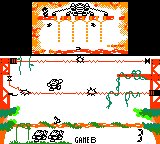Donkey Kong II
Donkey Kong II is a Game & Watch game released as part of the Multi Screen series on March 7, 1983.[1] It was later rereleased as part of Game & Watch Gallery 3. It is an indirect sequel to the Donkey Kong Jr. Game & Watch game and a direct follow-up to Donkey Kong. While Donkey Kong Jr. is based on the first level of the arcade game of the same name, Donkey Kong II appears to be based on the third and fourth levels. This game and Donkey Kong Jr. are the only times where Mario has ever been portrayed as an antagonist.
The alarm indicator of this game is a bell that is located beside the leftmost lock, and Mario strikes the bell with a drumstick when the alarm goes off.
Story
Essentially, this game contains the same story as Donkey Kong Jr.—Donkey Kong is trapped by the tricky Mario, and now the ape's son must save him.
Gameplay
Donkey Kong is chained to the floor in the top of the upper screen by several locks. Donkey Kong Jr. must hit a key up to the top screen and then progress through the bottom screen, jumping over Snapjaws and sparks much as Mario jumped over barrels in Donkey Kong. Every time Donkey Kong Jr. jumps over a Snapjaw or spark, he receives a point. When he reaches the top screen, he must hit the key right next to one of the locks, avoiding Nitpickers along the way, then climb up the chain that trails below the lock. Once he reaches the top, he uses the key to open the lock, earning from five to fifteen points depending on how fast he does the job. Then, he must progress back down to the bottom to hit a new key up, and so on. When Donkey Kong Jr. opens all four locks, he frees Donkey Kong, awarding the player 20 points. If Donkey Kong Jr., after opening a lock, has no misses when he returns to the starting position and throws up a key, he will earn five points. If a Snapjaw, Nitpicker, or spark hits Donkey Kong Jr., he loses a life, and the key returns to the starting position. If Donkey Kong Jr. reaches 300 points without any misses, the points will be worth double until he does get a miss. If he has any misses at said score, he will receive an extra life instead. The game ends when he loses three lives.
In Game A, the Snapjaws and Nitpickers on the upper screen disappear when Donkey Kong Jr. places the first key into the lock, with only the Nitpicker in the upper left corner and the Snapjaw in the lower right corner remaining. In Game B, however, the Snapjaws and Nitpickers remain when Donkey Kong Jr. places a key into the lock, making it more difficult for him to return.
Controls
: Move
: Jump
: Switch "main" screen
References to other games
- Donkey Kong – Donkey Kong II is its direct follow-up.
- Donkey Kong Jr. – Donkey Kong II is its indirect sequel. Both games share a very similar storyline. Also, Donkey Kong Jr. is identical in both appearances.
References in later games
- Donkey Kong 3 – A sequel to this game. Also, the handheld version of the sequel.
- Game & Watch Gallery 3 – Donkey Kong II is playable here.
Gallery
A sprite of Donkey Kong
A sprite of Mario
References
- ^ Donkey Kong II info page on In The Attic, a website dedicated to classic videogames Retrieved 13 November, 2010.
| Game & Watch games | ||
|---|---|---|
| Super Mario franchise | Donkey Kong (1982, MS) • Mario Bros. (1983, MS) • Mario's Cement Factory (1983, TT/NWS) • Mario's Bombs Away (1983, PS) • Donkey Kong Hockey (1984, MVS) • Super Mario Bros. (1986, CrS | 1987, Sp | 1988, NWS) • Mario the Juggler (1991, NWS) • Game & Watch: Super Mario Bros. (2020, CoS) | |
| Donkey Kong franchise | Donkey Kong (1982, MS) • Donkey Kong Jr. (1982, NWS | 1983, TT & PS) • Donkey Kong II (1983, MS) • Donkey Kong 3 (1984, MVS) • Donkey Kong Circus (1984, PS) • Donkey Kong Hockey (1984, MVS) | |
| Miscellaneous | Green House (1982, MS) | |
| MS: Multi Screen • TT: Table Top • PS: Panorama Screen • NWS: New Wide Screen • MVS: Micro VS. System • CrS: Crystal Screen • Sp: Special • CoS: Color Screen | ||

